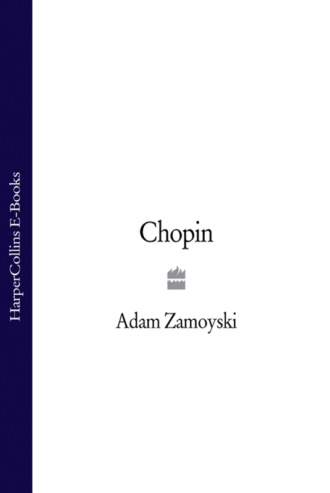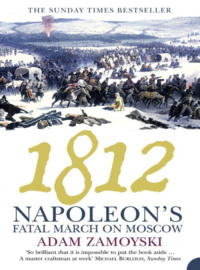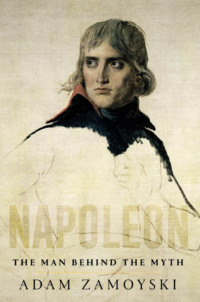
Полная версия
Chopin
This musical education was complemented by the music Chopin heard in homes and drawing rooms around Warsaw. Some of this was taken from the popular Italian operas of the day, but much of it was national in character. Polish piano music was dominated by the Polonaise, a musical form built on the rhythm of a slow, minuet-like court dance dating back to the sixteenth century. This rhythm had been familiar to many composers, including Bach, Telemann and Mozart, but they had merely used it as a tempo for melodies of their own. Towards the end of the eighteenth century Polish composers had begun to write Polonaises of a more authentic character. The trend was taken up by Prince Michał Kleofas Ogiński, a distinguished amateur composer, as well as the pianist Marya Szymanowska, and by the beginning of the nineteenth century the Polonaise had started a new life as a short piece for the piano.
Unsurprisingly, Chopin’s own first steps in composition took this form. By the age of seven he was already composing short pieces which Żywny would help him write out, as he had not yet mastered this skill. Few of these survive. Those that do are unremarkable, and are only impressive if the boy’s age is taken into account. It was in 1817 that Chopin’s first printed work appeared, privately published by Canon Cybulski of St Mary’s church, a friend of the Chopin family. It was entitled ‘Polonaise in G minor, dedicated to Her Excellency Countess Victoria Skarbek, composed by Frederick Chopin, a musician aged 8’. It is probable that his godfather, Count Fryderyk Skarbek, who had just returned from studies abroad and taken up a teaching post at Warsaw University, had helped to pay for this, which would account for the dedication to his sister. His godfather was also responsible for the article on Chopin which appeared in January 1818 in the Warsaw Recorder (Pamiętnik Warszawski) and hailed the young composer as ‘a true musical genius’. ‘Not only can he play with great facility and perfect taste the most difficult compositions for the piano,’ Skarbek wrote, ‘he is also the composer of several dances and variations which do not cease to amaze the connoisseurs.’9
The first known reference to Chopin’s appearance outside the family circle is to be found in the diary of a young lady who went to a soirée at Countess Grabowska’s, where ‘young Chopin played the piano, a child in his eighth year whom the connoisseurs declare to be Mozart’s successor’.10 Countess Grabowska, a friend of the Skarbeks, was the wife of one of the governors of Warsaw University, who was later to become Director of the Government Commission on Education. He belonged to a conservative patriotic milieu which had adopted a pragmatic approach to the realities of Poland’s position.
After Napoleon’s disastrous Russian campaign of 1812, the whole of Poland had been overrun by Russian troops, and Tsar Alexander was determined to hold on to as much of it as possible. At the Congress of Vienna in 1815 he managed to force through his solution to the Polish problem and created a small Kingdom of Poland whose constitutional king was the Tsar of Russia. It was a precarious compromise, and while many patriots regarded it as little better than captivity, a group of aristocrats worked at promoting the national cause within the limited autonomy it allowed.
The prime salon of this circle was that of the Blue Palace, the Warsaw residence of Count Stanisław Zamoyski. It was also the Warsaw home of his brother-in-law Prince Adam Czartoryski, whose close friendship with Tsar Alexander, distinguished diplomatic career and position as head of what was arguably the richest and most influential family in the Kingdom, made him a key figure in Polish society and politics. The Blue Palace was frequented by the most venerable figures of the past as well as the youngest members of the Polish aristocracy. Countess Zamoyska and her sister, Princess Marya of Württemberg, organised entertainments and thés dansants for children between the ages of eight and twelve, designed to instil good manners and patriotic values, which Chopin probably attended.11
The Countess was also the founder of the Warsaw Benevolent Society, and it was not long before she recognised Chopin’s fund-raising potential. Julian Niemcewicz, the poet and Nestor of Polish literature, a devotee of the Blue Palace, describes a meeting of the Society in one of his one-act plays:
The Countess: You see how little money we have; all our efforts come to nothing. We are begging high and low, but everyone is deaf to us, or rather, to the voice of the poor. There is nothing for it but to carry on with our usual methods, but with certain modifications. I flatter myself that Monsieur Łubieński and I have perfected our techniques. There is to be a concert next Tuesday in which little Chopin is to play; if we were to print on the bills that Chopin is only three years old, everyone would come running to see the prodigy. Just think how many people would come and how much money we would collect!
All: Bravo! Bravo! A wonderful idea, excellent! Let us print on the bills that Chopin is only three years old!
Princess Sapieha: I think it would make even more of a sensation if we wrote on the bills that little Chopin will be carried in by his nanny.
All: Bravo! Bravo! What a capital idea, princess! 12
What was probably the first of these concerts took place on 24 February 1818. Whatever the bills may finally have said, the press notice actually gave Chopin an extra year, stating that he was nine. The concert took place in the ballroom of a public building often used for such events, the former Radziwiłł Palace, and Chopin played a concerto by the Czech composer Adalbert Gyrowetz. It was his first appearance before such a large audience, and almost certainly the first time he had performed a work of this length.
After this event Chopin’s fame spread throughout the capital, and it was not long before a carriage would draw up before the Chopin apartment to carry the eight-year-old boy off to the Belvedere Palace, the residence of Tsar Alexander’s brother Grand Duke Constantine, commander-in-chief of the Polish army. Constantine was a martinet who spent his days drilling his soldiers mercilessly, often forcing them to perform feats that could only end in their death or that of their horses. He epitomised everything that was grotesque and brutal about Russian rule in Poland, and he was universally reviled.
Nicolas Chopin was not one to allow sentiment to get in the way of his son’s prospects. It was an honour for the boy to be asked to play at the Belvedere, and a triumph when it turned out that he could soothe the Grand Duke’s notorious fits of temper with his playing. Chopin presented him with a military march of his own composition, and it was said the Grand Duke was so delighted that he had it scored for full military band and played at parades. What was more remarkable was that Chopin was not fetched merely to entertain the Grand Duke and his wife, but to play with his beloved natural son and Alexandrine de Moriolles, the daughter of his tutor.13
Chopin’s was an unusual upbringing; from his sheltered home with its middle-class atmosphere, he was propelled into some of the most elegant drawing rooms in Europe, where he performed before the greatest personages in the country, was spoilt by their wives, and played on an equal footing with their children. He quickly acquired polished manners as well as an ability to feel at ease in the most exalted company and mix with any kind of person, and while he was sociable and a little precocious, he was not, by all accounts, conceited. There is a plausible anecdote relating to one of his first public appearances; when he returned home, his mother asked him what the audience had liked best, to which he is alleged to have replied: ‘My new English collar.’ Whether this is true or not, it is in character, as he would remain remarkably modest about his music throughout his life. This was largely the consequence of his father’s determination not to let his talent go to his head, and insistence on treating his son’s gift as a pleasant amenity rather than the central feature of his life. This redounds to Nicolas Chopin’s credit, consider ing how ruthlessly most child prodigies were exploited by their parents.
Nicolas Chopin was a product of the eighteenth century, and to him the profession of musician was hardly more respectable than that of actor. Having risen in the world himself, he was determined that his son should continue the ascent. Even when obliged to acknowledge his son’s exceptional gift, he would not allow him to exploit it in what he considered a socially demeaning way.
Chopin was shown off whenever this might improve his prospects. In 1818 the mother of Tsar Alexander and Grand Duke Constantine, the Empress Maria Feodorovna, visited Warsaw and indulged in the usual round of visiting institutions and schools. When she graced his class at the Lycée, the eight-year-old Chopin presented her with two Polonaises. At the end of 1819, when the famous singer Angelica Catalani came to give some concerts in Warsaw, the boy was again exhibited; she was so impressed that she presented him with an inscribed gold watch. He was also a regular performer at the Benevolent Society’s concerts, and often played at soirées in aristocratic houses. Charity events were permissible, as he performed alongside aristocratic amateur musicians or children reciting poetry, but there was no question of the boy playing for money or taking part in commercial concerts, for that would have branded him as a professional musician.
How Chopin saw himself by the time he had reached the age of eight is impossible to tell, but one thing is certain: that he already knew music to be his most personal form of expression. Every year on his name day in December, Nicolas Chopin was presented with little hand-painted greetings from his son. The verse offering for 1818 opens with the words: ‘Dearly beloved father; it would be easier for me to express my feelings in musical phrases…’14
He had by now learned to write down music, as can be seen from the beautifully written-out Polonaise he dedicated and presented to Żywny on the latter’s birthday in 1821, one of the few surviving compositions of this period. The majority of the pieces he wrote at this time remained in manuscript form among his own papers, with which they were later destroyed by Russian troops, or were written into albums, most of which suffered similar fates. Judging from the one or two pieces which have survived, they were clever but hardly distinguished.
At about the same time it became clear that Żywny’s task was over, and that there was no more he could do for Chopin. He remained a close friend of the family and often brought his violin to play duets with his pupil, but stopped giving him lessons.
While Żywny was not replaced by another teacher, and Chopin essentially worked at the piano on his own, he was not left entirely without guidance. The piano and organ teacher at the Conservatoire, the Bohemian-born Wilhelm Vaclav Würfel, who had worked in Vienna where he won the admiration of Beethoven, was a friend of the Chopin household, and he guided the boy on a friendly basis.
Another who contributed to Chopin’s musical education was Józef Elsner, a Silesian who had established himself in Warsaw some thirty years before. He was a prolific composer of operas, masses, oratorios, symphonies and chamber music, whose recently revived works reveal him as an interesting and original musician. He was also an excellent teacher, and had been appointed head of the newly founded Warsaw Conservatoire.
He was interested in drawing Chopin into this institution, so he gave him a few lessons in musical theory and presented him with a book on the rules of harmony. But for the time being Nicolas Chopin’s views on the boy’s future prevailed, and he would have no formal musical instruction over the next four years.
TWO School Days
The review of a charity concert in which Chopin had taken part in February 1823 concluded with the following observation:
The latest number of the Leipzig musical gazette reports, in an article from Vienna, that an equally young amateur by the name of List [sic] astonished everyone there by the precision, the self-assurance, and the strength of tone with which he executed a concerto by Hummel. After this musical evening, we shall certainly not envy Vienna their Mr List, as our capital possesses one equal to him, and perhaps even superior, in the shape of young Mr Chopin…1
Chopin himself would not have envied the Viennese prodigy. For while Franz Liszt, one year his junior, was steered into the gruelling career of performing musician, Chopin enjoyed a normal childhood. Later that year he donned the semi-military uniform of blue frock-coat with a single row of buttons and a high collar with a white stripe on it, and joined the fourth form of the Warsaw Lycée like any other schoolboy.
While he was by no means robust, he was neither sickly nor timid, and was among the most popular members of his class. Unaffected and unselfconscious as he was, ‘little Frycek’ had no difficulty in making friends. He won the avuncular and slightly protective friendship of older boys, such as Jan Białobłocki and Tytus Woyciechowski, respectively five and two years his senior. But he was also at the heart of a gang of the livelier members of his own class, such as Dominik Dziewanowski, Julian Fontana and Jan Matuszyński.
Chopin had an irreverent wit and a keen eye for the ridiculous. He drew incisive caricatures and satirised Poles speaking French or foreigners speaking Polish. He fooled about on the piano, making musical jokes or providing an accompaniment to stories. But it was his gift for mimicry that really astonished people. He could transform not only his expression, but his very appearance, and was barely recognisable when imitating one of the Lycée masters or some public figure. Many years later, the celebrated French actor Pierre Bocage was to say that Chopin had wasted his talents by becoming a musician.
But while he neglected no opportunity for fun, Chopin also worked hard, and at the end of the academic year in July 1824 he collected the fourth-form prize jointly with Jan Matuszyński. The real prize, however, was an invitation to go and stay in the country with his classmate Dominik Dziewanowski.
Apart from the occasional short visit the Chopin family had made to the Skarbeks at Żelazowa Wola, this was Chopin’s first real taste of the country. The Dziewanowski estate, Szafarnia, lay not far from Żelazowa Wola, on the flat Mazovian plain, west and slightly north of Warsaw, the only part of the Polish countryside with which Chopin was ever to become familiar. The estates in that area were not rich, and the country houses reflected this. The house at Szafarnia has not survived, but it probably conformed to the general pattern of timber or rendered brick manor houses: long and low, classical in style, with a colonnaded portico. These houses were often elegant, occasionally even grandiose in their conception, but the execution was sometimes rustic. The same went for life inside them, with the accent on comfort: there would be a piano in a fine drawing room, but there might be geese wandering about the back porch.
Chopin’s holiday in Szafarnia had undoubtedly been dictated, at least in part, by concern for his health, which was far from good; it is possible that he had contracted tuberculosis, which was widespread. He was armed with pills and put on a strict diet: six or seven cups of acorn coffee per day, various tisanes, plenty of food, a little sweet wine, very ripe fruit, but, much to his chagrin, no bread.
This did not mar his enjoyment, and his letters home are full of the excitement caused by the novelty of his experiences. The books he had brought from Warsaw were hardly opened, and although he played the piano a great deal, he wrote little during his stay. Most of his time was spent out of doors, running about with his friend Dominik, going for drives through the surrounding countryside, visiting their friend Jan Białobłocki, whose parents’ estate lay not far away, and even riding. ‘Don’t ask whether I ride well or not,’ he wrote to a friend in Warsaw, ‘but I do ride; that is to say the horse goes slowly where it wants, and I sit on it in terror, like an ape on the back of a bear; I haven’t fallen off yet, because the horse hasn’t bothered to throw me.’2 This was hardly surprising, since it was being led about on a rein by Dominik’s aunt Miss Ludwika Dziewanowska.
Chopin wrote most of his letters home in the form and under the heading of the Szafarnia Courier, a pastiche on the Warsaw Courier, using the same layout of Home News, Foreign News and Society News. The customary censor’s stamp was in this case applied by Miss Ludwika. The Szafarnia Courier is full of schoolboy wit, with detailed news of how many flies settled on his nose, arch descriptions of battles between farmyard animals, Homeric accounts of quarrels between servants and notes on the misdemeanours of the domestic cat. There is also a great deal on the comings and goings of the Jewish traders who were a ubiquitous part of country life, and whom Chopin treats with predictable mockery. But the Szafarnia Courier also gives some idea of his wry, hyperbolic sense of humour and of his tendency to ridicule himself, the Pichon of the entries:
On 26th Inst. Monsieur Pichon visited the village of Golub. Amongst other sights and wonders of this exotic place, he saw a pig (imported) which for some time totally absorbed the attention of this distinguished voyageur.3
Monsieur Pichon is suffering great discomfort on account of the mosquitoes, of which he has encountered fabulous quantities at Szafarnia. They bite him all over, except, mercifully, on the nose, which would otherwise become even bigger than it is. 4
On 1st Inst. Monsieur Pichon was just playing ‘the Jew’ [a newly composed Mazurka on a Jewish dance theme], when Monsieur Dziewanowski, who had business with one of his Jewish tenants, asked the latter to pronounce judgement on the young Jewish virtuoso’s playing. Moses came up to the window, inserted his exalted aquiline nose into the room and listened, after which he declared that if Mons. Pichon were to go and play at a Jewish wedding, he would earn at least ten thalers. Such a declaration encouraged Mons. Pichon to study this kind of music with diligence, and who knows whether one day he may not give himself over entirely to this branch of the arts.5
The fourteen-year-old boy found everything about life in the country new and interesting, but what fascinated him more than anything else were the unfamiliar sounds. The only popular music he had heard before was Warsaw street musicians’ renderings of folk songs and dances. As he listened to peasant girls singing their songs of love or sorrow, to the old women chanting in the fields, and to the drinking songs issuing from village taverns, a whole new world of music opened up before him. When he returned to Warsaw in September, it was with his head full of these new harmonies.
He had by now achieved such mastery of the keyboard that the Polonaises he turned out were far superior in technical terms to their Ogiński model. With the A flat major Polonaise, written in 1821 and dedicated to Żywny, he had moved on to writing in the so-called ‘brilliant’ style; it is a sparkling bravura piece designed to show off the virtuosity of the performer rather than to plumb the depths of musical expression. At the same time, he continued to seek the key to a deeper understanding of the language of music, following his own instinct and taking advantage of every opportunity to expand his knowledge.
He was profoundly affected by the new Italian music, represented most notably by the operas of Spontini and Rossini, now fashionable in Warsaw. It was being promoted by the conductor and composer Karol Kurpiński, himself the author of several operas in a similar style. Chopin was struck by the melodic brilliance and the ‘singing’ quality produced by the Italian composers, and strove to bring some of these into his own playing.
In his fourteenth year he began writing waltzes and Mazurkas (the Gallicised name of the mazur, the principal dance of the peasants of Mazovia) as well as Polonaises, often for more than one instrument. Lack of evidence precludes any serious analysis of his output, and the main source of information on the compositions of this period is the album of Countess Izabela Grabowska, which was fortunately described by a musicologist before it was lost in the war. The Countess was a cousin of Fryderyk Skarbek and an enthusiastic violinist, and as she lived not far from the Chopin apartment, the young composer spent a good deal of time with her.
Most of the music in the album was written, possibly in collaboration with the Countess, around 1824. The book contained a large number of compositions for the piano, and quite a few for piano and violin. The musicologist who examined it thought many of these unremarkable and imitative of Hummel, and noted a lack of experience and a certain untidiness in the way the harmonies were developed. But he was also astonished by the number of passages which showed originality and seemed to announce Chopin’s mature work.6
Chopin expanded his education and experience by taking part in a variety of musical events, most of them of an amateur nature. Documentary evidence is scarce, but we do know that he was closely involved in a series of musical performances put on by a friend of Nicolas Chopin, Józef Jawurek, the director of music of the Warsaw Evangelical church, which had a fine neo-classical rotunda with good acoustics. In 1824 and 1825 Chopin took part, along with his sister Ludwika and Jan Białobłocki, in performances of Haydn’s Creation and works by Elsner, and it is highly likely that he was involved in other similar events.7
In April 1825 the capital prepared for an official visit from Tsar Alexander, and it was Chopin who was singled out by the Warsaw instrument-maker Brunner and the inventor Professor Hoffmann to show off their latest invention, the eolomelodicon, at a public concert. It was a sort of miniature organ, and Chopin played part of a Moscheles piano concerto and an improvisation of his own on it at a grand instrumental and vocal concert at the Conservatoire on 27 May. As the makers had hoped, both the instrument and the boy’s playing caused such a stir that the Tsar came to hear of it, and a special recital was organised for him. This command performance took place in the Evangelical church, with Chopin dressed in his Lycée full-dress uniform of blue tailcoat, breeches and stockings, pumps with silver buckles and white gloves. The Tsar was so taken with his playing that he presented him and the makers of the instrument with diamond rings.8
This recognition coincided with the first commercial publication, on 2 June 1825, of one of Chopin’s works, the Rondo in C minor, op.1. The Benevolent Society managed to persuade all the artists who had taken part in the May concert to repeat their performance for charity on 10 June, and on this occasion Chopin played the newly published Rondo on the strange instrument, and then launched into a long improvisation, which earned him his first mention in the press outside Poland. The Allgemeine Musikalische Zeitung of Leipzig reported that ‘young Chopin distinguished himself in his improvisation by a wealth of musical ideas, and under his hands this instrument, of which he is a great master, made a deep impression’.9
International acclaim was one thing, but the laws of the Chopin family were rigid, and as the boy only had a month left before his end-of-year exams, he was made to apply himself to his work. ‘I have to sit and sit, sit, still sit, and perhaps sit up all night,’ he wrote to his friend Białobłocki, who had now settled in the country, adding in a subsequent letter that he would at best scrape through the exams.10 In the event, he once again jointly topped his class, this time with his friend Julian Fontana. The next day he rushed out to buy himself a new pair of corduroy breeches and then climbed into a carriage with Ludwika Dziewanowska, who had come to take him and Dominik to Szafarnia.










